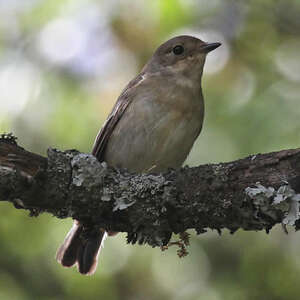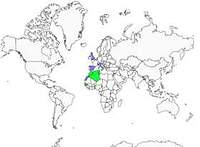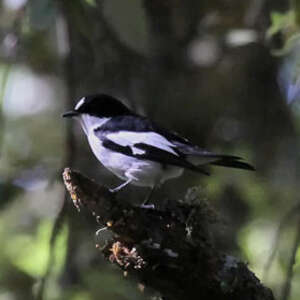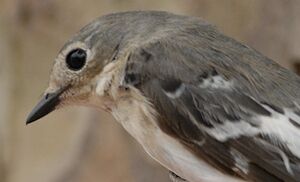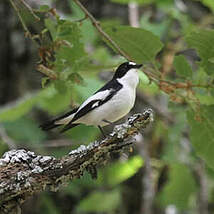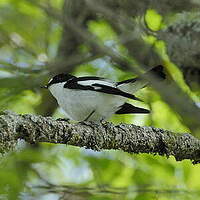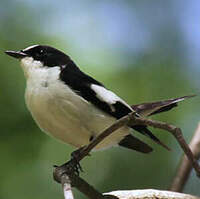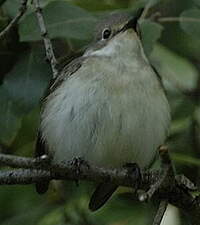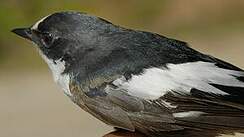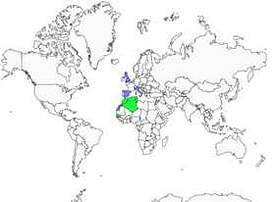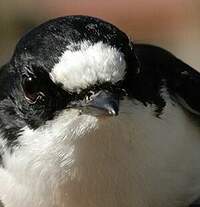Atlas Pied Flycatcher
Ficedula speculigera - Gobemouche de l'Atlas
Identification
The Atlas Pied Flycatcher is still sometimes considered as a subspecies of the European Black Flycatcher (Ficedula hypoleuca). In spring, males, unlike some Black Flycatchers, never seem to show any gray plumage. They differ from the Black Flycatcher by the large white spot on the forehead, a truly striking feature in nature, the absence of white at the base of the rectrices (not always easy to see) and a large white spot at the base of the primary remiges. These last two criteria put it closer to the Collared Flycatcher (Ficedula albicollis), from which it differs in the absence of white on the rump and white collar. This species is also very similar to the iberiae subspecies of the Black Flycatcher.
Females are gray and the white on the wings is much less extended than in males; they also don't have a spot on the forehead and are therefore very difficult to distinguish from those of other black-plumaged Flycatchers. The young of both sexes look very much like the females.
Subspecific information monotypic species
Foreign names
- Gobemouche de l'Atlas,
- Papamoscas del Atlas,
- papa-moscas-do-atlas,
- Atlasschnäpper,
- atlaszlégykapó,
- Atlasvliegenvanger,
- Balia dell'Atlante,
- atlasflugsnappare,
- Atlasfluesnapper,
- muchárik atlaský,
- lejsek atlaský,
- Berber-fluesnapper,
- atlaksensieppo,
- muchołówka atlasowa,
- Atlasa mušķērājs,
- Атласская мухоловка,
- アトラスマダラヒタキ,
- 非洲斑姬鹟,
- atlasflugsnappare,
- 阿特勒斯斑姬鶲,
Voice song and call
Habitat
Behaviour character trait
Dietfeeding habits
Reproduction nesting
In the northwest of Tunisia (El Feija National Park), in May 2012, only the males were clearly visible, most of the females being in the process of incubation. In Djurdjura (Algeria), the average date of the first egg-laying is on 26th May (85 egg-laying). The size of egg-laying varies between 4 and 7 eggs (average of 5.22 eggs/egg-laying for 35 egg-laying from Algeria and Morocco). In this country, young Atlas Pied Flycatchers can be found at the nest from the end of May to mid-July.
Geographic range
The Atlas Pied Flycatcher is an endemic species of the Maghreb mountains, from the High Atlas of Morocco in the west to the mountains of Kroumirie in Tunisia in the east. It is usually found above 800 m in altutude. Almost nothing is known of its migratory movements or its wintering areas (one winter data in Ivory Coast). The birds usually return to their breeding grounds in the third decade of April. They leave at the end of August, some staying until the beginning of October (7 October 1984 in Morocco).
Threats - protection
IUCN conservation status
concern
in the Wild
threatened
evaluated
Sources of information
- IOC World Bird List (v15.1), Gill, F and D Donsker (Eds). 2025-12-07.
- Le guide ornitho : Le guide le plus complet des oiseaux d'Europe, d'Afrique du Nord et du Moyen-Orient : 900 espèces, Svensson, Mullarney, Zetterstrom
- Oiseaux d'Algérie, Isenmann P. Moali A.
- Oiseaux de Tunisie, Isenmann P., Gaultier T., El Hili A., Azafzaf H., Dlensi H. Smart M.
- The birds of Morocco, Thévenot M., Vernon R. Bergier P.
- Birds of the Western Paleartic interactive, Cramp Simmons
- xeno-canto, Sharing bird sounds from around the world,
Other sources of interest
 Specification sheet created on
31/07/2023 by Georges Olioso
Specification sheet created on
31/07/2023 by Georges OliosoTranslation by AI Oiseaux.net
© 1996-2026 Oiseaux.net
- Accipitriformes
- Aegotheliformes
- Anseriformes
- Apodiformes
- Apterygiformes
- Bucerotiformes
- Caprimulgiformes
- Cariamiformes
- Casuariiformes
- Charadriiformes
- Ciconiiformes
- Coliiformes
- Columbiformes
- Coraciiformes
- Cuculiformes
- Eurypygiformes
- Falconiformes
- Galliformes
- Gaviiformes
- Gruiformes
- Leptosomiformes
- Mesitornithiformes
- Musophagiformes
- Nyctibiiformes
- Opisthocomiformes
- Otidiformes
- Passeriformes
- Pelecaniformes
- Phaethontiformes
- Phoenicopteriformes
- Piciformes
- Podargiformes
- Podicipediformes
- Procellariiformes
- Psittaciformes
- Pterocliformes
- Rheiformes
- Sphenisciformes
- Steatornithiformes
- Strigiformes
- Struthioniformes
- Suliformes
- Tinamiformes
- Trogoniformes

